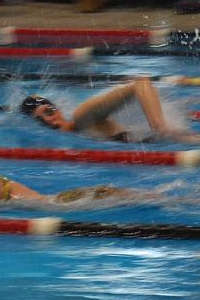| 
|
Video Stroke Improvement - Session
1
Introduction: Initial video will be captured, one swimmer at a
time in the edge lane. While this is happening, the other swimmers will
have a drill focus workout, learning and practicing a number of drills
used to develop a good setup. The setup is basically everything
you need to do to get into position to take a good stroke. If you don't
get the setup right, it's hard to perform a good stroke.
During the week before the second session, a webpage will be created
for you. That page will contain your video clips with voice-over comments
and a set of recommendations. During the second session you will focus
on learning the drills suggested to address the issues described on the
initial video.
Armstroke Setup Position
You should be in this position before beginning your catch and pull:
- Maximum body rotation to one side - this is 90° for many drills
- where the extra rotation is a purposeful exaggeration, but only about
45° when swimming freestyle
- Lower arm extended out front: fingertips slightly below wrist, wrist
slightly below elbow, elbow slightly below shoulder.
- Head neutral on spine with eyes looking straight down at the bottom
Armstroke Setup Drill Sequence
- Extended Side Balance:
lower arm extended, upper arm resting on side; switch sides at each
wall. Note: If you are not comfortable with the Side
Balance drill (kicking on your side with both arms at your sides),
master that drill before performing this one - both drills are described
here.
- 6-1-6: Kick about six kicks in the extended side balance position.
Then take a single stroke focusing on driving the middle finger straight
ahead of your shoulder. Breathe after the stroke (not before).
- 6-1-6 Broken Arrow: Similar to the above in terms of the timing:
kick in side balance for a bit, take a single stroke, and then kick
in side balance on the other side. The difference is in how you recover
your arm: lift your arm straight up in the air - fingers pointing to
the ceiling - hold it there for a count of two, then "break"
your elbow and spear your hand forward into the water, straight ahead,
in front of your shoulder. When your arm is in the air, do not let it
go behind your back - keep it above your side or to the front of your
body. Again, breathe after the stroke (not before).
- 6-1-6 Sharkfin: Like the Broken Arrow drill, but just
point your elbow to the ceiling and pause with your elbow pointing up
only long enough to say "point." Focus on your elbow: lift
your arm out of the water using your elbow, point to the ceiling with
your elbow, and drive your hand into the water using your elbow. Remember
to breathe after the stroke (not before).
- 6-1-6: Repeat the 6-1-6 drill focusing on using your elbow
to lift your arm out of the water and then spear your hand forward in
front of your shoulder - all in one continuous, smooth action. Again
breathe after the stroke (not before).
Note: This type of armstroke setup is best for open water,
fitness or distance swimming. It is usually called the high elbow recovery.
It is not the best way to recover your arm when sprinting. If you are
a masters or age group swim racer competing at shorter distances, you
should develop one or more additional types of arm recovery that are more
appropriate for sprinting. But don't ignore this one - good swimmers use
different technique for different speeds, often during the same race.
This is your most efficient, standard, long-distance, open water recovery
technique.
For more details about the setup, see Freestyle
Arm Stroke Setup.
Back.
|

